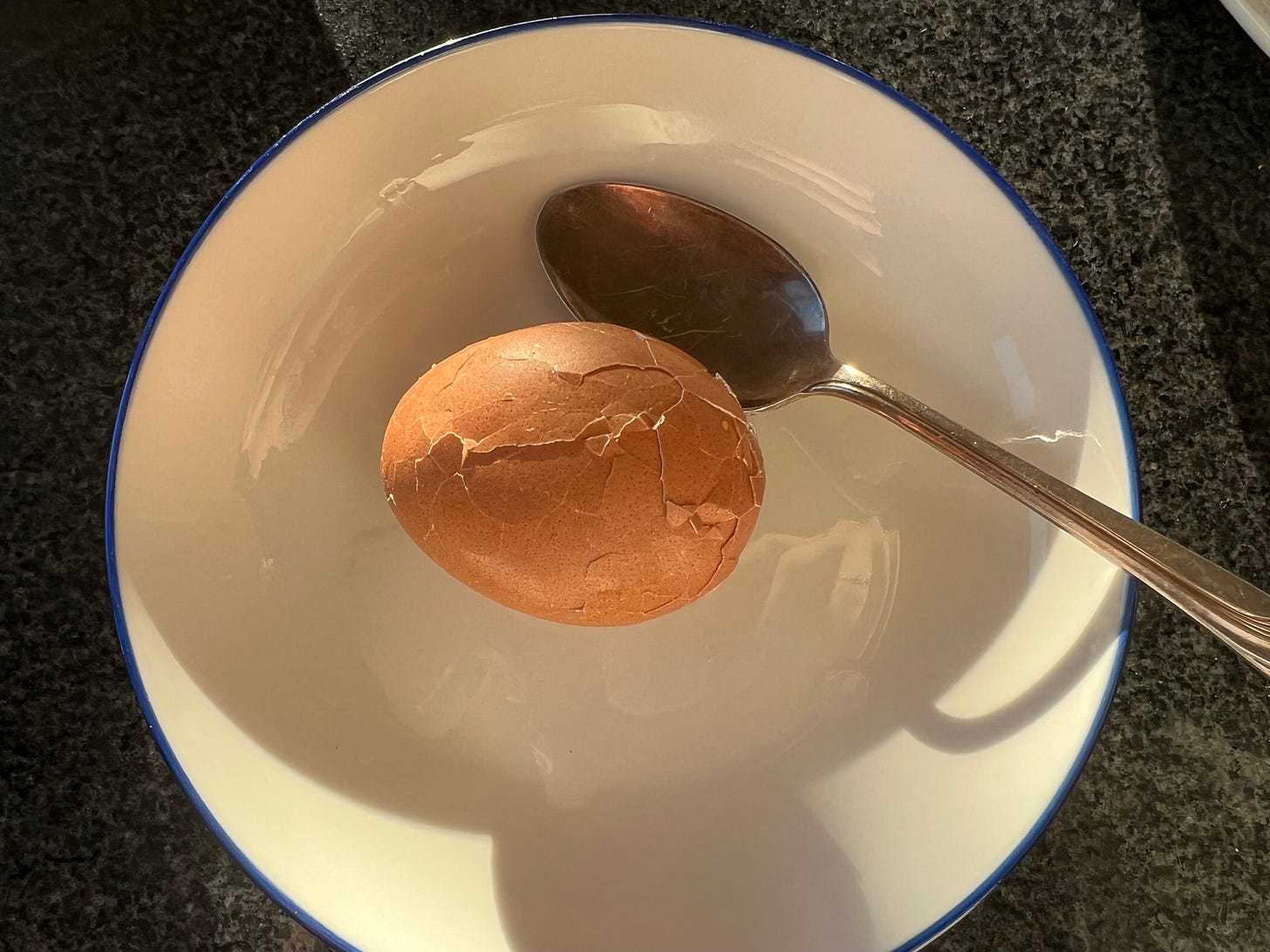I tested a viral TikTok hack so you wouldn't have to.
Is it all it's *cracked* up to be?🍳
Hiya,
How are you over there in your kitchen? Here in mine, I’ve been hyper-fixating on a very specific breakfast: toasted sourdough topped with butter, avocado mash (half an avocado, a quarter lemon, a big pinch of salt), and a six and a half minute egg. It’s delicious, yes, but it was also born of necessity. I’ve been testing a TikTok hack for you and my little kitchen experimentations have left me with quite a few boiled eggs.
Have you seen this? If you’re not into TikTok links or don’t have two minutes and forty three seconds to spare, TL;DR the original poster claims that tapping an egg using the back of a spoon until you hear a very specific ping (watch the video if you want to hear it—the tapping starts at 1:24—I can’t really convey it in writing) is the key to seamlessly peel-able boiled eggs.
The tapping and subsequent ping are supposedly an indication that the egg has separated from its inner membrane—if you’ve ever struggled to peel a hardboiled egg, then I’m sure you know that the pesky membrane between the shell and the egg itself can be a paper-thin but mighty barrier between you and a beautifully peeled boiled egg.
This particular cooking tip more than intrigued me, so over the past few days, I set out to testing it. Let’s get into the results:
But first, let me explain how I went about testing this hack. We all learned about the scientific method in elementary school, right? In keeping with it, I designed a little experiment where the only variable I changed was whether or not an egg had been tapped and pinged. Otherwise, I boiled both tapped and untapped eggs the exact same way, here’s how:
I like a soft-ish boiled egg. My typical method is to bring a full pot of plain water (side note: have you made it to WaterTok, yet? fascinating stuff…) to a rolling boil, then slowly lower my room-temperature egg into it and let the egg bathe for six and a half minutes. After its dip in the boiling water, I move the egg over to an ice bath, where it stays until it’s fully chilled down (around 3 minutes). To peel my egg, I like to use the convex side of a spoon to give some firm taps—much firmer than the ones used when the egg was raw—to break the shell all over, then peel it away. I used this method across all the eggs I tested.
My findings:
In my tests, all my eggs—tapped and pinged or not—peeled extremely easily. This could be for a variety of reasons that I can think of: my eggs are supermarket eggs that have been in my fridge for around a week, so not extremely fresh, some say an ice bath after boiling makes for easier peeling, and I know that cracking the egg all over before attempting to peel it often makes for faster peeling.

So, does it work?
I mean, kinda? In scientific method speak, I’d say that my results are inconclusive. All the eggs peeled easily, so the tapping and pinging certainly didn’t hurt in a peel-ability sense. The main difference I found between the eggs that had been tapped and those that hadn’t was that the tapped eggs were more prone to cracking once they were in the boiling water. This is, obviously, not ideal. And to be clear, the tapping and pinging does not break the shell at all. Give it a try yourself, it’s pretty interesting to hear and see IRL.
Because my current method works for me and doesn’t lead to many prematurely cracked shells, you likely won’t find me tapping away at my eggs before boiling them in the future.
However! The tapping and pinging does seem to work well in another, slightly less sensational way. I found that tapping away at the egg before cracking it open raw for use in a scramble or baked good is a worthwhile pursuit. After that very specific ping, and a good thwack on the side of a bowl, the entire raw egg comes pouring right out of the shell with almost no albumin (egg white) left over in the shell. It’s considerably less messy than cracking an un-pinged raw egg. Next time I’m making an omelet or a cake, I can absolutely see myself taking an extra second to tap my eggs. There’s a way to avoid getting uncooked egg white all over our hands and countertops and this is it!
So! In conclusion, this little hack does seem useful, just not in the way I was expecting it to be. I’m so curious, had you seen this before? Have you tried it? Would you? I’d love to hear from you via email, in the comments section of this post, or in my DM inbox.
And with that, I’ll leave you with my wishes that you have a well-fed week ahead.
xx
Erica
Want more? I’m so flattered! You can also follow me on Instagram or TikTok, or check out my tips-laden e-book collection. The newest addition, Meal Prep Made Simple, is available to order now!






Hey there! Long time follower, first time commenter.
Have you ever considered writing a college cooking cookbook? I feel like you would do so well there.